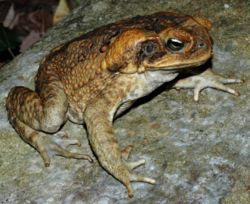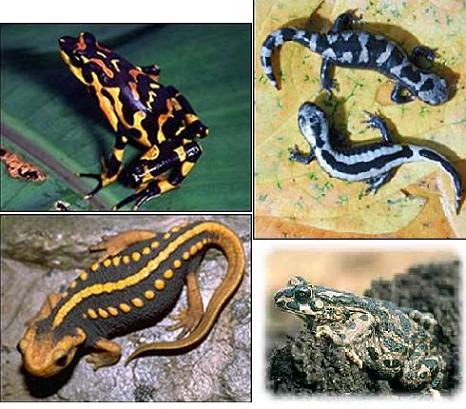Amphibians are a sort of intermediate link between the fish in the water and the reptiles on land and belong to the department of vertebrates, about 250 genera are divided into about 5800 species and many more that are unknown to science and await discovery and definition

Amphibians are a sort of intermediate link between the fish in the water and the reptiles on land and belong to the vertebrate class, about 250 genera divided into about 5800 species, and many more that are unknown to science and await discovery and definition. Toads, frogs, salamanders, newts: they are, according to what is known, the first vertebrates that succeeded and to live on land, about 350 million years ago, from being adapted to many different habitats (due to reincarnations) that enable life in dry deserts on the one hand and swamps and bodies of water on the other, in dark caves and estuaries of streams and rivers, an adaptation that resulted in a wide distribution, on all continents except Antarctica.
Amphibians are the only vertebrates that undergo a clear and extreme change of form (metamorphosis) from a young (tadpole) to an adult form. Despite their evolutionary success (perhaps because of) most of them need external moisture to complete the life cycle - to go through the stages of incarnation - egg, tadpole, adult, and it is possible that this need is in their bodies, since the need for moisture is to absorb air (partial respiration), all the two Living at one stage in their life, or at all stages, they keep their skin moist, and as a result come in continuous, full and intense contact with their environment / air or water, such contact means a high sensitivity to all the components in the environment, even if in minute concentrations components in our new environment, mainly thanks to human activity, Many of them are poisons. Indeed, the amphibians are considered by the field people as the first source of warning for any negative change in the environment - like the canaries in the mines that were used to warn the miners about toxic concentrations in the air, so the amphibians are used for environmental researchers.
Here are some facts:
In Cameroon lives the largest frog in the world, it barely survives because it is hunted for food, in South Asia and the East it is common to hunt frogs and toads for food (the French raise the toads for food in breeding "farms"), colorful frogs from South America and Madagascar, are hunted and sold in "pet" stores ", to this day the toad is used as a "convenient" animal for surgeries and for studying nervous and muscular systems in many universities and research institutes.

A wild hunter brings the giant salamander in China to the brink of extinction, the Chinese hunt the salamander whose weight can reach fifty kg! In order to eat, the salamander is considered a food of lust as well as arousing its "dormant powers", so are more than thirty species of frogs that are sold in the Chinese markets dried and used in folk medicine. "Exotic", as an important source of animal protein, as a source of medicine and poison, or as pets, amphibians are hunted and sold all over the world, and in order to maintain their continued existence on the one hand and on the other hand not to harm the residents/indigenous people who earn their living and make a living from hunting and trading in amphibians, the hunting and trading must be regulated So that it does not harm the hunter nor the hunted. That is, a sustainable use that will allow confirmation and regeneration of the amphibian populations.
In an indirect connection to our negative impact on the environment, a deadly fungus was recently discovered in the British Isles, deadly to amphibians, the fungus was known in laboratory animals and was distributed around the world at a time when there was a demand for toads for pregnancy tests, tests that were carried out by injecting urine (the subject) into a frog, (if The frog would go into heat - the woman is pregnant!). The fungus was discovered in American frogs that were brought as "pets" and escaped into the wild. In neighboring Europe, the fungus caused severe damage to frogs and toads, throughout the continent, so also in Australia and Western Asia. as experimental animals in laboratories.
About a third of amphibians are at risk of extinction due to: viral diseases caused by environmental pollution, direct poisoning, loss of habitats and hunting. To stop the deterioration of the condition of the amphibians, scientists gathered in Washington for a conference (15,10) at the end of which it was decided on a project to collect species and breed them in captivity worldwide, the cost of the project will be about 400 million dollars (over the next five years), with the budget coming from Greens" and the UN. What sparked the recognition of urgency is a survey conducted by the world conservation organization IUCN. According to the survey, out of about 5800 known species, thirty are no longer there!
A hundred additional species have not been observed for a long time and are therefore "suspected" of being lost!
The (single) cause that seems to be the most dangerous for the existence of amphibians is the fungus Batrachochytrium dendrobatidis, which was first diagnosed about six years ago and is today found in Europe, America, and Australia. Apparently, environmental stress - dryness, pollution, etc. weakens the animals' natural resistance and increases their vulnerability to this disease, as well as to other hazards.
Environmental stress is defined as: loss of living areas, climatic changes, poisoning - chemical pollution, suppression by invasive species and of course wild gathering (poaching). Because of their sensitivity to the environment, the amphibians are harmed at an early stage, a stage in which the environmental changes are not visible to the naked eye, and therefore it is important to check the effect of new substances that man emits into the environment, since current damage to amphibians means the future poisoning of many animals, including man!
When amphibians show signs of distress and stress, it is a sign that their environment is damaged, a damaged environment - sick, is an environment where humans will also be in distress, therefore it is important to maintain a healthy environment and one of the ways to do this is to ensure the continued healthy existence of the amphibians!

3 תגובות
It's so big you don't understand anything
Why is it written so big it's hard to read it and I would like you to add how the two lives fit into their living environment Thank you very much Lior....
A toad is an amphibian